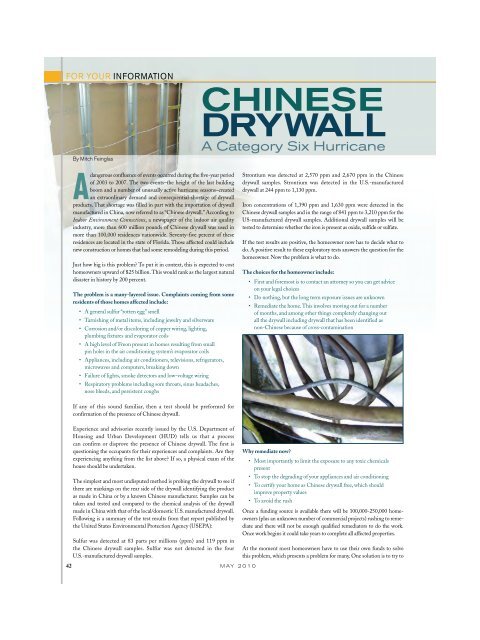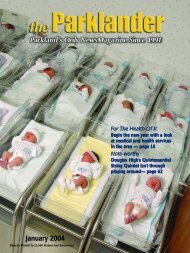celebratingour 2 0 thyear - The Parklander Magazine
celebratingour 2 0 thyear - The Parklander Magazine
celebratingour 2 0 thyear - The Parklander Magazine
- No tags were found...
You also want an ePaper? Increase the reach of your titles
YUMPU automatically turns print PDFs into web optimized ePapers that Google loves.
FOR YOUR INFORMATIONCHINESEDRYWALLA Category Six HurricaneBy Mitch FeinglasAdangerous confluence of events occurred during the five-year periodof 2003 to 2007. <strong>The</strong> two events–the height of the last buildingboom and a number of unusually active hurricane seasons–createdan extraordinary demand and consequential shortage of drywallproducts. That shortage was filled in part with the importation of drywallmanufactured in China, now referred to as “Chinese drywall.” According toIndoor Environment Connections, a newspaper of the indoor air qualityindustry, more than 600 million pounds of Chinese drywall was used inmore than 100,000 residences nationwide. Seventy-five percent of theseresidences are located in the state of Florida. Those affected could includenew construction or homes that had some remodeling during this period.Just how big is this problem? To put it in context, this is expected to costhomeowners upward of $25 billion. This would rank as the largest naturaldisaster in history by 200 percent.<strong>The</strong> problem is a many-layered issue. Complaints coming from someresidents of those homes affected include:• A general sulfur “rotten egg” smell• Tarnishing of metal items, including jewelry and silverware• Corrosion and/or discoloring of copper wiring, lighting,plumbing fixtures and evaporator coils• A high level of Freon present in homes resulting from smallpin holes in the air conditioning system’s evaporator coils• Appliances, including air conditioners, televisions, refrigerators,microwaves and computers, breaking down• Failure of lights, smoke detectors and low-voltage wiring• Respiratory problems including sore throats, sinus headaches,nose bleeds, and persistent coughsStrontium was detected at 2,570 ppm and 2,670 ppm in the Chinesedrywall samples. Strontium was detected in the U.S.-manufactureddrywall at 244 ppm to 1,130 ppm.Iron concentrations of 1,390 ppm and 1,630 ppm were detected in theChinese drywall samples and in the range of 841 ppm to 3,210 ppm for theUS-manufactured drywall samples. Additional drywall samples will betested to determine whether the iron is present as oxide, sulfide or sulfate.If the test results are positive, the homeowner now has to decide what todo. A positive result to these exploratory tests answers the question for thehomeowner. Now the problem is what to do.<strong>The</strong> choices for the homeowner include:• First and foremost is to contact an attorney so you can get adviceon your legal choices• Do nothing, but the long term exposure issues are unknown• Remediate the home.This involves moving out for a numberof months, and among other things completely changing outall the drywall including drywall that has been identified asnon-Chinese because of cross-contaminationIf any of this sound familiar, then a test should be preformed forconfirmation of the presence of Chinese drywall.Experience and advisories recently issued by the U.S. Department ofHousing and Urban Development (HUD) tells us that a processcan confirm or disprove the presence of Chinese drywall. <strong>The</strong> first isquestioning the occupants for their experiences and complaints. Are theyexperiencing anything from the list above? If so, a physical exam of thehouse should be undertaken.<strong>The</strong> simplest and most undisputed method is probing the drywall to see ifthere are markings on the rear side of the drywall identifying the productas made in China or by a known Chinese manufacturer. Samples can betaken and tested and compared to the chemical analysis of the drywallmade in China with that of the local/domestic U.S. manufactured drywall.Following is a summary of the test results from that report published bythe United States Environmental Protection Agency (USEPA):Sulfur was detected at 83 parts per millions (ppm) and 119 ppm inthe Chinese drywall samples. Sulfur was not detected in the fourU.S.-manufactured drywall samples.42 MAY 2010Why remediate now?• Most importantly to limit the exposure to any toxic chemicalspresent• To stop the degrading of your appliances and air conditioning• To certify your home as Chinese drywall free, which shouldimprove property values• To avoid the rushOnce a funding source is available there will be 100,000-250,000 homeowners(plus an unknown number of commercial projects) rushing to remediateand there will not be enough qualified remediators to do the work.Once work begins it could take years to complete all affected properties.At the moment most homeowners have to use their own funds to solvethis problem, which presents a problem for many. One solution is to try to
















